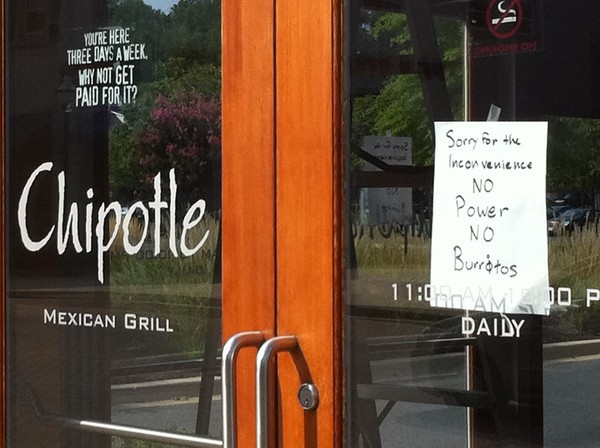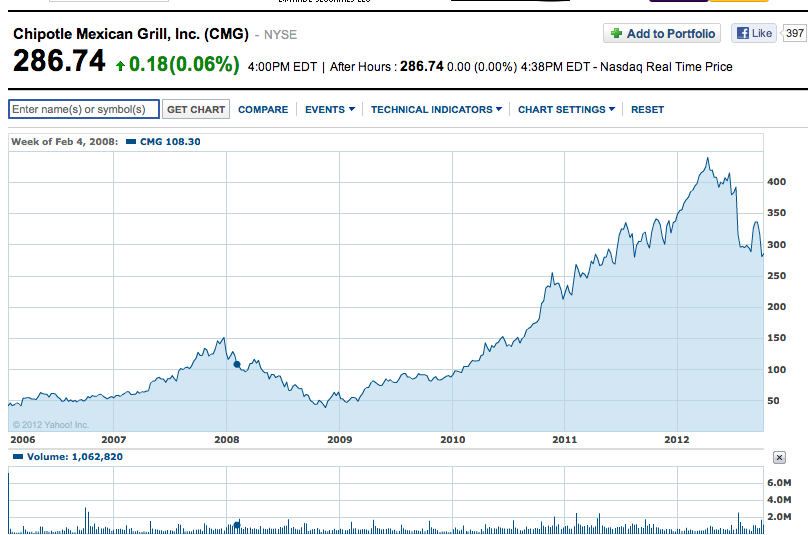Because there just aren’t enough stories about Apple as an investment, we’re adding our own. Why not? Apple is to personal finance as Tim Tebow is to ESPN First Take. Even if nothing of note is happening with the subject at hand, we still need to not only talk about it, but do so until the readers/viewers weep and beg us to discuss any other topic.
You’re going to have to wait a couple more days. In the last few months Apple has gone from in danger of passing ExxonMobil to become the biggest corporation on Earth, to passing ExxonMobil, to Apple’s stock price setting an acme, to it losing 10% off that high and therefore still being a topic of concern. You know, because no stock in the history of the world has ever reached its lifetime peak and then fallen 10%. Only Apple. Groundbreaking as usual.
A couple of weeks ago USA Today used an effective gimmick for a) attracting readers and b) continuing to give Apple undue attention: the misleading headline. Even better, USA Today posed the headline as a question so that no one could accuse them of sensationalism.
Do too many people own too much Apple stock?
Which not only has less zing than
Too many own too much Apple stock
But isn’t even news. Heck, it isn’t even research. The writer, Matt Krantz (subject of a recent post), starts with a conclusion and works his way back to the premises. Which is what journalists all too often do.
Sparing you from Mr. Krantz’s breezy introduction, we get to the meat of his “argument” a few paragraphs in. (This isn’t an inverted pyramid, it’s a pyramid that’s been ransacked and left to rubble.)
(I)nvestors have found that zeroing in on this one company is their ticket to a big Wall Street score. The stock has been a winner despite its recent decline, which briefly pushed it into a 10% correction. At its close of $635.85 Tuesday, it’s still up more than 50% this year, which compared with the 15% gain in the broad Standard & Poor’s 500 index makes it a runaway winner.
Get rich from a single stock? Without having bought it before everyone else did? Sure, sounds at least as solid a strategy as playing blackjack is. Diversity is overrated, anyway. Here’s the next fanciful line:
“I don’t want to diversify that much when I have one stock doing just fine,” says Matt Loud, a 28-year-old security worker in Bellingham, Wash., who has upwards of 38% of his retirement accounts in Apple.
We were going to track down Mr. Loud and ask him if what he said is true. Failing that, we’d find Mr. Krantz and ask him how he just slipped that into his story without asking Mr. Loud how hard a surface the delivering doctor dropped his head on. Fortunately, Twitter did the work for us.
Here’s a Tweet from @MatLoud to @MattKrantz dated October 2 (before the story ran, but whatever):
@mattkrantz apple plays a key role in my investments but I don’t have a substantial amount of outright shares.
So what does the USA Today quote even mean? How can you have 38% of your retirement savings in a company’s stock but “(not) have a substantial amount of (its) outright shares”?
Using Aristotelian logic, the only possibility is that Mr. Loud was referring to Apple stock in absolute terms, rather than relative ones, in the tweet. A standard lot of Apple stock is 100 shares, which would be worth $63,585. That’s 38% of $167,328, which would be a snappy nest egg for a 28-year-old unskilled worker with a disjointed Twitter account.
The other possibility is that Mr. Loud made the numbers up and/or doesn’t know what he’s talking about, and a journalist with a deadline and a conclusion needed something to flesh out his story.
Loud is part of a crowd of investors who have become infatuated owners of Apple — and richly rewarded as a result.
Then why wouldn’t you tell us how much he bought his stock for? Sounds like an important point, doesn’t it? Is he dollar-cost averaging? Did someone will him the stock? Did he buy it at its 2002 bottom? No, none of this is important.
Personal finance is useless unless you quantify. It’s not “I feel pretty good about my 401(k) balance.” It’s “I’ve got $145,342.99 in there, split between Vanguard’s Admiral Treasury Money Market Fund and its 500 Index Admiral Shares Fund. I contribute $1,950 monthly and my employer matches it.” If you don’t quantify, you don’t have any business investing.
Imagine Al Michaels telling us, “It seems like it’s been a lot of games since Drew Brees didn’t throw a touchdown pass.” Or Paul Ryan saying, “Our national deficit sure is big.”
It gets much worse. The author interviews a 35-year-old San Francisco housewife who claims she first bought Apple in 2007 (it ranged from $85 to $200 that year) and now holds ¾ of her portfolio in it. This is assuming she’s telling the truth. Later in the story she says she doesn’t like the new 9-pin connector, and what that has to do with investing, rather than consuming, we’re not sure.
The same housewife “worries…how much higher can it go”, then contradicts that worry by claiming that if it hits $750, she’ll sell. And will then have at least 78% of her portfolio in cash, assuming her other investments stay constant.
There’s a similarly depressing story about a retired soldier who has “nearly 40%” of his portfolio in Apple.
At Control Your Cash, we treat journalists with slightly less disdain than we do pederastic college football coaches. Check your sources? Not when there’s popular folklore to reinforce. We don’t believe that any of the interview subjects indeed have the listed percentages of their retirement savings in Apple, because we doubt the interview subjects even know what buttons on the calculator to press to divide their Apple holdings by their total holdings, let alone know how much Apple they hold.
The lies don’t stop there, either:
Nearly 17% of all individual investors own Apple shares
According to SigFig, a site Mr. Krantz contacted for his story.
Really? Every 6th individual investor in the country holds AAPL?
From Apple’s latest 10-K, and if you don’t know what a 10-K is, just buy our book already:
As of October 14, 2011, there were 28,543 shareholders of record.
Which would mean that there are only about 168,000 individual investors in the country. Also from the 10-K,
929,409,000 shares of Common Stock Issued and Outstanding as of October 14, 2011
Okay, now we’re the ones playing with facts. There are more than 28,543 individuals who own Apple. It’s just that most people own their shares via brokerage accounts. As far as Apple knows, your shares are under the name “Morgan Stanley” or “Charles Schwab”, not “Jane Doe”. As are your neighbors. It’s impossible to tell exactly how many people own Apple at a given time.
But we can estimate, and we can start by comparing apples to apples. Microsoft has 128,992 shareholders of record. Alcoa has 319,000. Exxon Mobil has 486,416. Apple isn’t America’s most widely held stock, or anything close to that.
We could pick apart more of this story, but that’s not the point. The point is –
Alright, one more folkloric quote:
Apple investors, on average, have nearly 17% of their portfolios riding on that one stock.
That’s either impossible, or it includes the Apple directors and officers who have enough of the stock that they’ll be rich no matter what. (We’re guessing SigFig didn’t interview them.) Commonplace, you-and-me investors don’t have anywhere near 17% of their holdings in Apple. And if they did, the examples cited in the story wouldn’t be remarkable.
Alright, we’re back. The point is that if you read the financial news, even from a trusted outlet, even from the nation’s biggest newspaper, be skeptical. Nowhere near 1/6 of individual investors have a piece of Apple. No one who has ¾ of her money in Apple knows anything about anything, especially if she’s a dilettante with no coherent investing strategy.
And to answer the author’s rhetorical query? No, not too many people own too much Apple stock. Not even close. After 3 decades, the stock finally started paying a dividend, which will reduce liquidity. It’s trading at less than 15 times earnings, which is not only less than the S&P 500 average but hardly indicative of a bubble that’s reached maximum surface tension.
Would we buy it? No, because the $63,585 initial investment is a little too much for us to commit to when there are other investments available. Doesn’t mean you shouldn’t bite, though. Nor does it mean you shouldn’t invest in a mutual fund that prominently features Apple. Like PowerShares QQQ Trust, which is comprised 20% of Apple and is up 19% this year.
Question everything. Think about whether a quantitative claim makes any sense. And don’t take investment advice from 20-something security guards, impulsive housewives, nor the journalists who indulge them.






